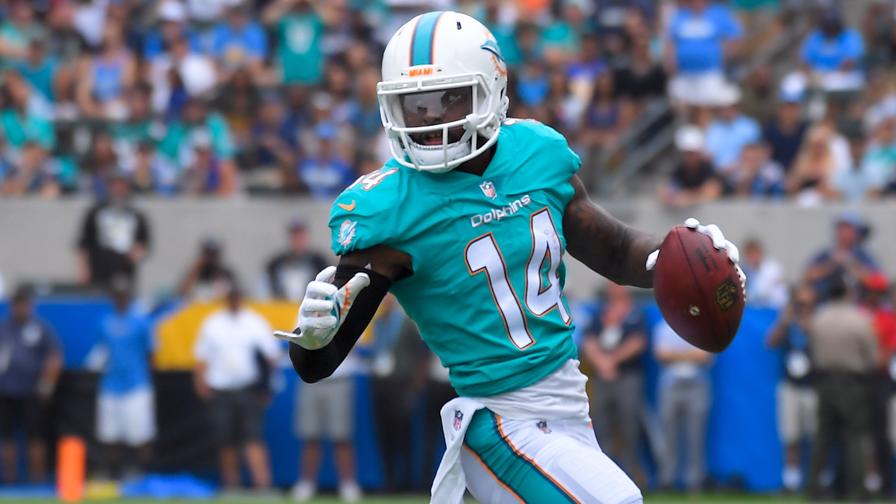Jarvis Landry Is as Inefficient as Ever

Jarvis Landry came into the NFL as part of a stacked wide receiver class in 2014. He was the 12th pass-catcher taken in that class, and while he currently ranks 4th in receptions, he’s also just 14th in receiving yards. That’s still impressive in a vacuum, but the shift in rank from receptions to yards is a big one.
For example, the three players ahead of him in receptions -- Antonio Brown, Julio Jones, and Demaryius Thomas -- are all among the top four in receiving yards. Odell Beckham, who is fifth in receptions, leaps Thomas in yards.
How important of a role does Landry have on the Miami Dolphins offense? He constantly gets fed the ball -- which can make him a dream in fantasy football -- but the quality of those receptions has long been in question.
By Net Expected Points (NEP), Landry has consistently rated as one of football's least efficient high-volume receivers. In his previous three seasons, the wideout has ranked no higher than 30th in Reception NEP per target among receivers with 100-plus targets. Even if we just look at the counting stat of Reception NEP, he hasn't ranked any better than 24th among this group, which can be seen below.
| Year | Reception NEP | Rank | Reception NEP/Target | Rank |
|---|---|---|---|---|
| 2014 | 63.29 | 33 (of 41) | 0.57 | 34 (of 41) |
| 2015 | 82.26 | 25 (of 32) | 0.49 | 32 (of 32) |
| 2016 | 83.96 | 24 (of 41) | 0.64 | 30 (of 41) |
A Step Back
So far, the 2017 version of Landry has been even worse and less efficient. There are 56 receivers who have seen at least 20 targets so far this year, and Landry has taken his customary spot in the rankings with regard to Reception NEP (55th) and Reception NEP per target (56th).
To put this further into perspective, his Reception NEP per target through three games is sitting at 0.19, which is 0.12 behind the 54th-ranked receiver, Cole Beasley. It's also worth noting that the average among this 56-receiver group is 0.66.
It’s hard to convey how far below average that is by just stating it, so take a look at the graph below, which marks the Reception NEP per target of all 56 receivers with 20 or more targets in 2017. The green bar all the way to the right is Landry.

He's done this while still having the third-best catch rate of that group (75.80%), but only 48% of Landry's receptions have gone for first downs, which is well below the rate of teammate DeVante Parker (61%). Parker has just 18 receptions so far this year -- with 11 that have gone for first downs -- compared to Landry's 25 (and 12).
Among that same group of receivers we touched on above, only 13 of them currently own a Success Rate -- which is the percentage of catches that contribute to a positive NEP -- below 80.00%. Landry's 60.00% Success Rate is the lowest of them all, with the next-lowest rates being Rashard Higgins and Golden Tate at 67.00%.
Last year, Tavon Austin was the worst highly-targeted receiver in the league after posting a Reception NEP per target of 0.27 and a Success Rate of 66.00%. The Los Angeles Rams rectified that by no longer making Tavon Austin a highly targeted receiver.
Short Usage
Much of Landry’s inefficiency comes from how he’s used on the field. Check out the route graph below from NFL’s Next-Gen Stats highlighting his Week 2 performance, where he had 13 receptions for 78 yards. It was just the fourth game since 1985 with at least 13 receptions and fewer than 80 receiving yards -- two of which were done by running backs.

The white is the route, the green is after the catch. Only three of his targeted routes went more than five yards past the line of scrimmage. One was just barely over five yards, the second was incomplete, and third went to the sideline with nothing after the catch for 11 yards. That’s not efficient for any type of receiver, yet that’s been Landry’s role, especially this season. There’s clearly a place for a possession receiver who can move the chains, but those receivers do have to at least move the chains.
This is an important campaign for Landry because it's a contract year for him -- this is the final season of his rookie contract, which doesn't have a fifth-year option since he was a second-round pick. There’s been no news whether an extension is even being considered since the end of August.
If Landry and the Dolphins can’t figure out how to improve his efficiency, it'll be even harder for him to make a case that he should be considered among the top receivers in football once he hits the open market.
















